
The cryptocurrency world is no stranger to dramatic shifts, but the recent reported performance of UTK has sent shockwaves across the market. On July 23, 2025, a staggering figure emerged: UTK was reported to have experienced a 24-hour price drop of 596.88%, settling at $0.03214. This alarming statistic, while mathematically impossible for a direct price decline from its current value (as a price cannot drop more than 100%), serves as a stark indicator of the extreme pressures and panic that gripped the token, signaling a profound loss of value and confidence. Such reported figures, even if stemming from data anomalies or misinterpretations, underscore the urgent need for investors to understand the true nature of UTK price drop and the inherent risks in volatile digital assets.
Understanding the Reported UTK Price Drop: A Closer Look
While a direct price decline of over 100% is not possible in real terms (a token’s value cannot fall below zero), the reported 596.88% drop for UTK highlights a critical situation. This figure likely represents a dramatic and rapid depreciation, perhaps a cumulative loss relative to previous highs, or a data reporting anomaly that nonetheless points to a catastrophic event for the token. Let’s break down the reported movements:
- 24-Hour Reported Decline: 596.88% (reported to $0.03214) – This figure, despite its mathematical peculiarity, signals an unparalleled level of selling pressure and investor capitulation within a single day.
- 7-Day Decline: 187.17% – Further reinforcing the severity, this sustained drop indicates that the token has been under intense pressure for over a week, moving beyond a momentary flash crash.
- 1-Month Surge: 2099.89% – Ironically, the month leading up to this crash saw a monumental surge. This suggests extreme speculative activity, followed by a brutal correction, highlighting the ‘pump and dump’ potential or unsustainable growth cycles often seen in altcoins.
- 1-Year Decline: 6473.31% – This long-term perspective paints the bleakest picture, indicating that despite any short-term rallies, UTK has been on a persistent downward trend, eroding investor wealth over a significant period.
This confluence of figures paints a vivid picture of a token caught in a whirlwind of extreme cryptocurrency volatility, where short-term speculative gains are quickly wiped out by deeper, more fundamental declines.
Navigating Extreme Cryptocurrency Volatility: What Does UTK’s Fall Mean?
The saga of UTK is a powerful reminder of the inherent volatility within the crypto markets. Unlike traditional assets, digital currencies can experience monumental price swings in incredibly short periods due to a confluence of factors:
- Market Sentiment: Crypto markets are heavily influenced by news, social media trends, and investor psychology. Negative news, even if unverified, can trigger widespread panic selling.
- Liquidity Issues: Smaller tokens, especially those outside the top cryptocurrencies, often have lower liquidity. This means large buy or sell orders can disproportionately impact price, leading to sharp spikes or crashes.
- Regulatory Uncertainty: Evolving regulations worldwide can create uncertainty, causing investors to pull funds from perceived risky assets.
- Project Fundamentals: The underlying health, development progress, and adoption of a blockchain project are crucial. Significant price drops often signal concerns about a project’s viability or its ability to deliver on promises.
UTK’s dramatic fall underscores how quickly fortunes can turn. For traders and investors, understanding these drivers of cryptocurrency volatility is paramount for effective risk management.
The Broader Impact on the Altcoin Market
When a token like UTK experiences such a significant downturn, it rarely operates in isolation. Its performance can send ripples throughout the broader altcoin market. Here’s why:
- Investor Confidence: A high-profile crash in one altcoin can erode overall investor confidence in the sector, leading to a flight to safety towards Bitcoin or stablecoins.
- Contagion Risk: While not as prevalent as in traditional finance, a severe crash in one token can sometimes trigger panic selling in other, similarly structured or related altcoins, especially if they share common investors or liquidity pools.
- Risk Aversion: Such events prompt investors to re-evaluate their portfolios, often leading to a more conservative approach and a reduction in exposure to speculative altcoins.
The UTK situation serves as a cautionary tale, emphasizing the importance of thorough due diligence before investing in any part of the dynamic altcoin market.
Assessing Digital Asset Performance: A Long-Term Perspective for UTK
While the 24-hour and 7-day drops are alarming, the 6473.31% decline over the past year for UTK provides crucial context for its overall digital asset performance. This long-term bearish trend suggests deeper issues than mere short-term market fluctuations. Such a profound decline typically points to:
- Fundamental Weaknesses: The project may be struggling with adoption, development delays, competition, or a lack of clear utility.
- Loss of Community Trust: Sustained price declines often lead to a loss of faith among early supporters and potential new investors, creating a downward spiral.
- Market Irrelevance: In a rapidly evolving crypto landscape, projects that fail to innovate or gain traction can quickly become obsolete, leading to a steady decline in value.
For any digital asset, consistent negative performance over a year is a significant red flag, indicating that the project may be facing existential challenges rather than just market cycles.
UTK Token Analysis: What’s Next and How Should Investors React?
Given the dramatic price action and long-term bearish trend, a thorough UTK token analysis is essential for anyone holding or considering this asset. The immediate outlook remains highly uncertain, with continued volatility expected. For investors, several key considerations come to the forefront:
- Risk Management is Paramount: Never invest more than you can afford to lose. The UTK case is a stark reminder of the potential for total capital loss in highly speculative assets.
- Diversification: Spreading investments across different assets and sectors can help mitigate the impact of a single asset’s poor performance.
- Research Beyond the Hype: Look beyond short-term pumps. Deep-dive into a project’s whitepaper, team, technology, use case, community engagement, and tokenomics.
- Stay Informed: Monitor official project announcements, market news, and expert analyses. Be wary of unverified information, especially on social media.
- Re-evaluate Positions: For existing holders, it’s crucial to objectively assess whether the project’s fundamentals align with your investment thesis, or if it’s time to cut losses.
While some brave investors might see such a dramatic dip as a potential buying opportunity, the overwhelming data suggests extreme caution. The path to recovery for a token with such a long-term negative trajectory and recent catastrophic price action is incredibly challenging.
Conclusion: A Wake-Up Call for Crypto Investors
The recent reported UTK price drop serves as a sobering reminder of the exhilarating yet perilous nature of the cryptocurrency market. With a reported 596.88% drop in 24 hours and a 187.17% decline over seven days, UTK is undoubtedly in a severe correction phase. While its 2099.89% one-month surge offered a brief glimpse of hope, the overwhelming 6473.31% decline over the past year paints a stark picture of long-term struggle. This event underscores the critical need for robust risk management, thorough due diligence, and a realistic understanding of cryptocurrency volatility. As the market continues its unpredictable evolution, UTK’s future will be closely watched, offering valuable lessons on the extreme highs and devastating lows that characterize the digital asset landscape. Investors must remain vigilant, informed, and strategic in their approach to navigating these turbulent waters.
Frequently Asked Questions (FAQs)
Q1: Is a 596.88% price drop mathematically possible for a cryptocurrency?
No, a direct price drop of over 100% is mathematically impossible for any asset. If an asset drops 100%, its value becomes zero. A reported figure like 596.88% likely indicates a severe data anomaly, a cumulative percentage loss over a longer period misrepresented as 24 hours, or a significant miscalculation that nonetheless highlights an extremely dramatic and concerning decline in value.
Q2: What caused the recent dramatic decline in UTK’s reported value?
While the exact triggers are often complex, dramatic drops like UTK’s are typically caused by a combination of factors: extreme selling pressure, significant negative news or developments related to the project, broader market downturns impacting the altcoin market, liquidity issues for the token, or a loss of investor confidence following unsustainable previous pumps.
Q3: What does UTK’s long-term performance (6473.31% drop over a year) signify?
A sustained decline of this magnitude over a year is a strong indicator of fundamental issues with the project. It suggests a lack of adoption, failure to meet development milestones, intense competition, or a general loss of relevance in the rapidly evolving crypto space. It points to deep-seated problems affecting the token’s long-term viability and investor trust.
Q4: How can investors protect themselves from extreme cryptocurrency volatility?
Investors can protect themselves by practicing robust risk management. This includes only investing what you can afford to lose, diversifying your portfolio across different assets, conducting thorough research (due diligence) before investing, setting stop-loss orders, and staying informed about market trends and project developments. Avoid chasing hype and be wary of highly speculative assets.
Q5: Is UTK likely to recover after such a significant drop?
While recovery is always possible in the volatile crypto market, a token experiencing such a dramatic reported UTK price drop and a severe long-term decline faces an extremely challenging path. Recovery would require significant positive developments, renewed investor confidence, and a reversal of its fundamental issues. Investors should exercise extreme caution and conduct extensive research before expecting a rebound.



